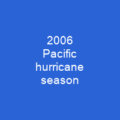Iniki was the most powerful hurricane to strike the U.S. state of Hawaii in recorded history. Formed on September 5, 1992, during the strong 1990–1995 El Niño, Iniki was one of eleven Central Pacific tropical cyclones during that season. It attained tropical storm status on September 8 and further intensified into a hurricane the next day. Iniki struck the island of Kaua’i on September 11 at peak intensity; it had winds of 145 mph and reached Category 4 status on the Saffir–Simpson hurricane scale. The storm struck just 18 days after Hurricane Andrew, the costliest tropical cyclone ever at the time, struck Florida.
About Hurricane Iniki in brief

It may have begun as a tropical wave that exited the African coast on August 18. It moved westward across the unfavorable Atlantic Ocean and crossed Central America into the Pacific on August 28. It continued rapidly westward and remained disorganized, and, as the convection concentrated around a center, the wave was classified Tropical Depression Eight18-E onSeptember 5. It remained weak until September 8, when it slowed enough to strengthen to a tropical storm. It reached hurricane status onSeptember 9 while 470 miles south-southeast of Hilo. As Iniki turned to the north, it continued to strengthen, reaching a peak of 145 mph winds on September 10 while 170 m miles south of Poʻipū on the islandof Kaua’i. The subtropical ridge, which typically keeps hurricanes well away from the Hawaiian Islands, weakened due to an approaching upper level-trough and allowed Iniki to turn to the northwest. After the storm hit Kauai, it rapidly accelerated north-northeastward, weakened, and became extropical. It dissipated on September 14 about halfway Between Hawaii and Alaska. It destroyed more than 1,400 houses and severely damaged more than 5,000. It also caused $3.1 billion in damage.
You want to know more about Hurricane Iniki?
This page is based on the article Hurricane Iniki published in Wikipedia (as of Dec. 05, 2020) and was automatically summarized using artificial intelligence.







